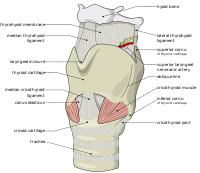
Photo from wikipedia
Abstract In the classic source–filter theory, the source of sound is flow modulation. “Flow” is the flow rate ( Q ) and flow modulation is d Q /d t .… Click to show full abstract
Abstract In the classic source–filter theory, the source of sound is flow modulation. “Flow” is the flow rate ( Q ) and flow modulation is d Q /d t . Other investigators have argued, using theoretical, computational, and mechanical models of the larynx, that there are additional sources of sound. To determine the acoustic role of d Q /d t in a tissue model, Q needs to be accurately measured within a few millimeters of the glottal exit; however, no direct measures of Q currently exist. The goal of this study is to obtain this waveform in an excised canine larynx model using time-resolved tomographic particle image velocimetry. The flow rate data are captured simultaneously with acoustic measurements to determine relations with vocal characteristics. The results show that glottal waveform characteristics such as maximum flow declination rate are proportional to the subglottal pressure, fundamental frequency, and acoustic intensity. These findings are important as they use direct measurements of the volume flow at the glottal exit to validate some of the assumptions used in the source–filter theory. In addition, future work will address the accuracy of indirect clinical measurement techniques, such as the Rothenberg mask. Graphical abstract
Journal Title: Experiments in Fluids
Year Published: 2020
Link to full text (if available)
Share on Social Media: Sign Up to like & get
recommendations!